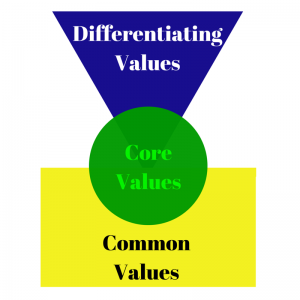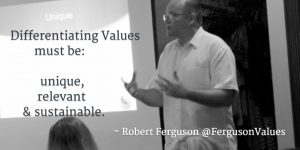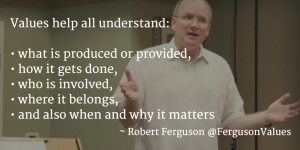A Shift in Marriage Continuity: from Reliability to Break-Fix
 The institution of marriage was designed to be permanent. As stated in a marriage vow:
The institution of marriage was designed to be permanent. As stated in a marriage vow:
“… to have and to hold from this day forward for better or for worse, for richer for poorer, in sickness and in health, to love and to cherish, till death do us part.”
Marriage and continuity were considered synonymous. As a differentiating value, Continuity means uninterrupted connection or union; permanence.
However, in past few decades there appears to be a shift in how to maintain continuity in a marriage. The old way was to ensure a solid foundation at the start, and work hard to prevent interruptions or breaks in the union.
Today, preserving continuity in marriage is more often about how quickly can it be fixed when it breaks. More couples than ever appear to accept the fact that major problems will arise and breakdowns will occur.
To help explain this shift in thinking, let’s do a brief comparison to an industry that has witnessed a major shift in how continuity is viewed – telecommunications.
Learning from a Major Industry Shift
![]() In the “old” world of telecommunications, the industry was obsessed with five 9s reliability. This meant that phone systems would remain on and working properly 99.999% of the time. Or put another way, the amount of down time was less than 5 ½ minutes per year! In the world of technology, that’s amazing reliability.
In the “old” world of telecommunications, the industry was obsessed with five 9s reliability. This meant that phone systems would remain on and working properly 99.999% of the time. Or put another way, the amount of down time was less than 5 ½ minutes per year! In the world of technology, that’s amazing reliability.
This meant that upfront investments in technology were very high. Any new innovation had to first prove it could pass the test of five 9s reliability. Nothing was allowed to break this standard.
Then along came a wave of new technologies that offered consumers a whole host of new services and flexibility never before considered possible. The most common label of this technology is VoIP (Voice over Internet Protocol). It meant that we could make phone calls over the Internet, from any computer.
But… the reliability of this new technology is very subpar. It can’t even achieve two 9s reliability (meaning 99% uptime or 87 hours a year downtown). Just think how often your Internet connection at home drops or is really slow. Or consider how often you can’t get a signal with your cellphone, or calls are dropped.
Yet consumers and business have embraced this new technology with full force. Why? Because the “new” telecommunications industry has figured out how to fix problems quickly.
This is a fascinating case where the importance of continuity has been preserved, but the method of achieving it has changed.
The same appears to be true for the modern marriage.
The Modern Marriage Shift
Fifty years ago, much energy was put into ensuring couples had a solid foundation, before they got married. Concerns were raised around family backgrounds, socio-economic compatibility, and potential prospects for the future.
It was not uncommon to hear such descriptive terms:
- The two of them make a great couple.
- They both come from solid families.
or
- She’s not a good fit for him.
- He’ll never amount to anything.
Biases were obvious because everyone wanted to preserve a standard. The goal was to ensure continuity in every marriage and that required more upfront scrutiny.
In addition, if or when something broke in a marriage, it was up to the couple to fix it themselves, and to keep going. Maintaining continuity of the marriage was of utmost importance.
But things are different in our modern world.
 Now, getting married is treated much more casually, and more and more couples are choosing to avoid marriage altogether by simply “living together.” Few people ever show much concern about who one chooses to marry (or live with). In fact, it’s considered taboo now to make any reference to race, religion, education, income, occupation or family background. The only question asked is “Do you love him/her?”
Now, getting married is treated much more casually, and more and more couples are choosing to avoid marriage altogether by simply “living together.” Few people ever show much concern about who one chooses to marry (or live with). In fact, it’s considered taboo now to make any reference to race, religion, education, income, occupation or family background. The only question asked is “Do you love him/her?”
With the rise of online dating sites, relationships are sought almost exclusively on interests, likes, and hobbies. Thus it’s much more common to hear of a couple who met online and then chose to get married on a beach in the Caribbean.
When problems arise (and they always do), the questions now being asked are:
- How fast can it be fixed?
- Who can help us fix it?
This helps explain the increase in the number of marriage counselors. Not only are there more counselors than ever to choose from today, but couples can choose from counselors with differing viewpoints, training, and backgrounds. With the single objective of fixing what’s broken, couples are looking for “who is the best one to help fix this?”
Of course, if it can’t be fixed easily, then many counselors recommend breaking the marriage and suggesting each partner start over. Simple. Easy. Cost-effective.
Or is it….
A Concern for the Future
Lots of research has proven that strong healthy marriages produce strong healthy families. There are fewer health problems, higher incomes, and happier people. It’s both rationally and morally sound.
So, in a world where the institution of marriage is often being cast aside as “the old way” it behooves couples to look deeper into what’s required to preserve continuity of their relationship – through marriage – today. The break-fix model might be the “new” normal. But are the trade-offs worth it in the long run?
Just as the hunt continues to discover new innovations that will improve the reliability of the Internet and wireless phones, we should also be exploring how to improve the continuity of the modern marriage.
Future generations are depending on it.
Do you agree or disagree with this trend of a break-fix model in modern marriages?
What do you recommend to help preserve continuity in marriage today?
Today’s value was selected from the “Harmony-Order” category, based on the e-book Developing Your Differentiating Values.







